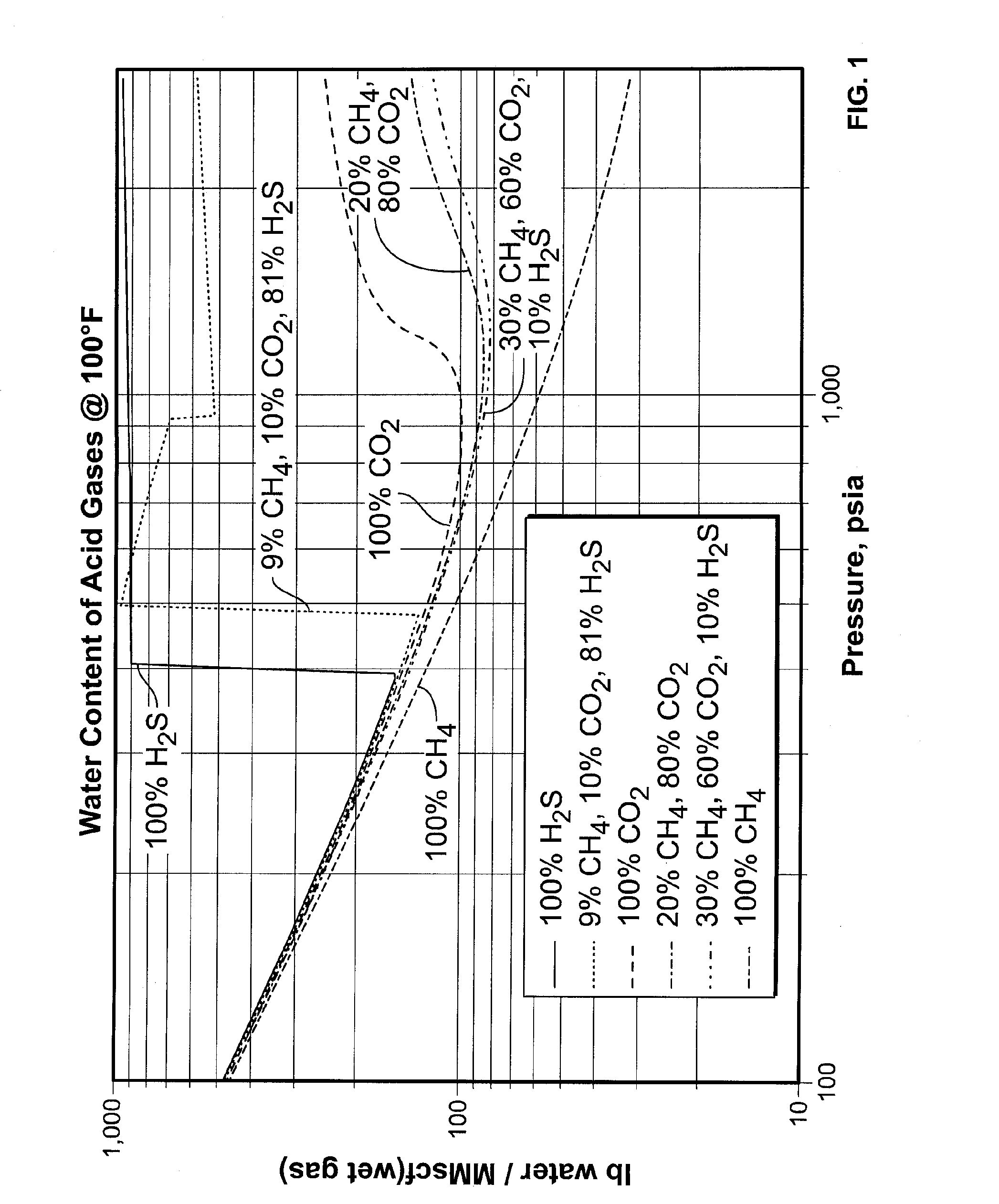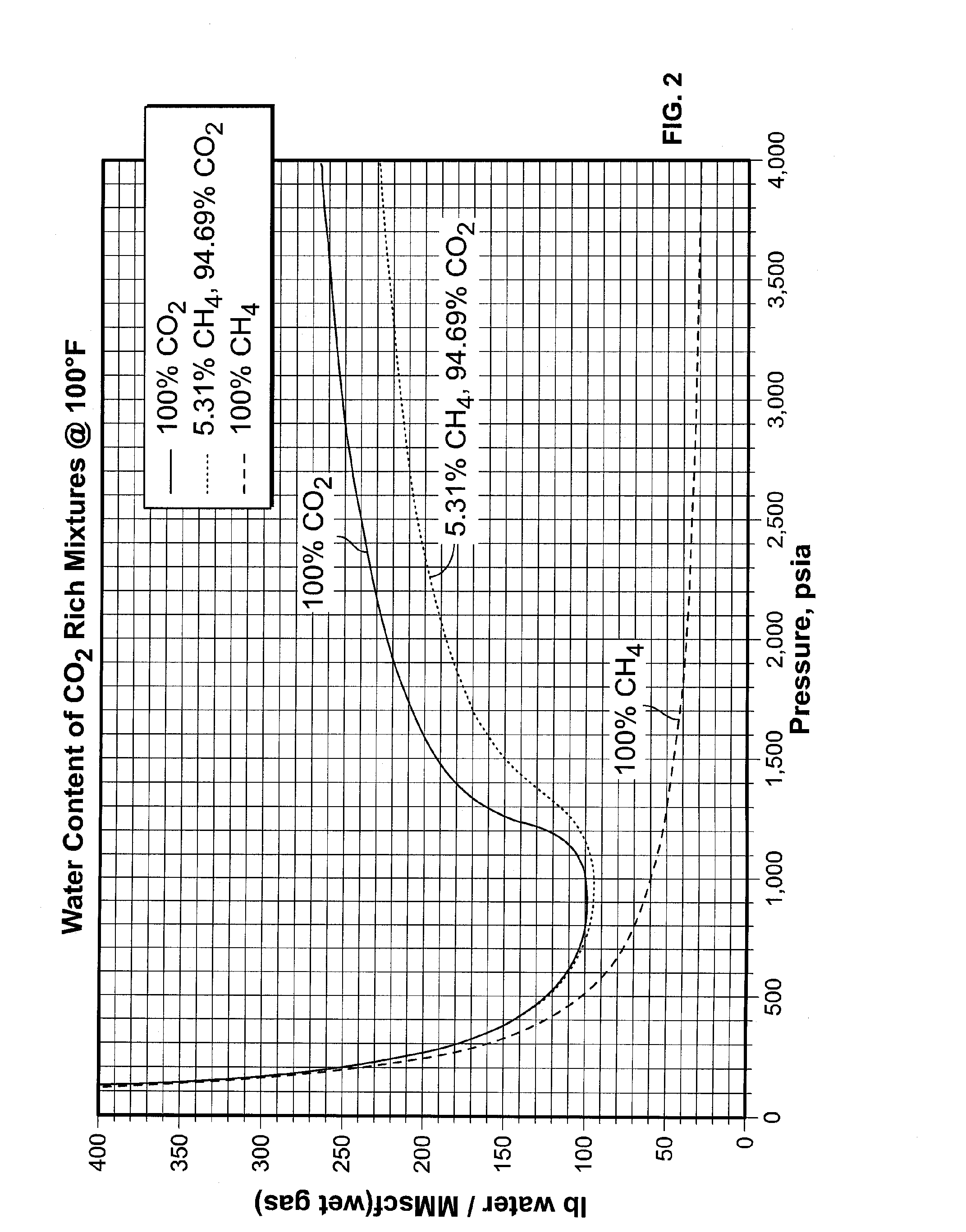Process for removing condensable components from a fluid
- Summary
- Abstract
- Description
- Claims
- Application Information
AI Technical Summary
Benefits of technology
Problems solved by technology
Method used
Image
Examples
example 1
Basic
[0048]Having reference to FIGS. 4A and 4B, in an embodiment of the invention, a water saturated acid gas feed stream 10 enters a suction stage 12 where it is compressed 14 to the suction pressure of the next stage 16. The hot compressed vapour 14 is cooled 18 with an after-cooler 20 resulting in the condensation of some of the water and other condensables in the feed stream. The condensed liquid containing water is removed 22 in a separator 24 upstream of the final stage of compression. The saturated gas 26 from the separator 24 is further compressed at 28 and is after-cooled again at 30.
[0049]A slipstream 32 from the compressed and after-cooled fluid stream is removed and isenthalpically expanded 34 across a Joule-Thomson valve (TCV) 36 to the lower suction pressure of the same stage 16 of compression. The expansion results in a temperature reduction, the magnitude of which is dependent upon the magnitude of the pressure reduction and the composition of the fluid stream. The c...
example 2
Heat Exchanger (HEX)
[0052]In cases where the composition of the feed stream, in combination with a large pressure reduction, creates a stream temperature which is below the hydrate formation temperature of the main undehydrated feed stream, the embodiment shown in FIGS. 4A and 4B can be modified to include a heat exchanger (HEX).
[0053]In reference to FIGS. 5A and 5B, the basic embodiment is modified so as to avoid the need for continuous injection of hydrate inhibitor, as is utilized in conventional refrigeration processes.
[0054]In FIGS. 5A and 5B, the slipstream 34 is partially expanded 42 across a second Joule-Thomson Valve (JTV) 44. The temperature of the partially expanded stream is thereafter raised in a heat exchanger 46 prior to further expansion of the stream 48 across the Joule-Thomson Valve (TCV) 50. Thus, the temperatures of the partially and fully expanded streams 42, 48 are maintained above the respective hydrate formation temperatures of the main undehydrated feed stre...
example 3
Low Temperature Separator (LTS)
[0058]Referring to FIGS. 6A and 6B, an embodiment of the invention utilizes an additional separator where temperature reduction is significant, as an alternate to the embodiment described in Example 2.
[0059]As shown in FIGS. 6A and 6B, the 46 and JTV 44 of FIGS. 5A and 5B are replaced with a second low temperature separator (LTS) 52. A slipstream 54 is expanded 56 across a Joule-Thomson Valve (TCV) 44. The first separator 24 is positioned to remove as much water as possible from the feed stream prior to the reintroduction of the expanded slipstream 48. The addition of hydrate inhibitor into the expanded slipstream 48 is considered when the process design requires that the temperature of the expanded slipstream be below 32° F. The early removal of the water reduces the amount of cooling required to meet the design conditions and, should conditions warrant, reduces the amount of hydrate inhibitor required.
[0060]The design hydrate formation temperature fo...
PUM
 Login to View More
Login to View More Abstract
Description
Claims
Application Information
 Login to View More
Login to View More - R&D
- Intellectual Property
- Life Sciences
- Materials
- Tech Scout
- Unparalleled Data Quality
- Higher Quality Content
- 60% Fewer Hallucinations
Browse by: Latest US Patents, China's latest patents, Technical Efficacy Thesaurus, Application Domain, Technology Topic, Popular Technical Reports.
© 2025 PatSnap. All rights reserved.Legal|Privacy policy|Modern Slavery Act Transparency Statement|Sitemap|About US| Contact US: help@patsnap.com



